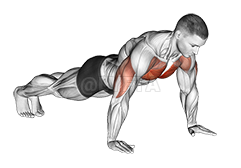
Push-up
Exercise Profile
Related Exercises:
Introduction to the Push-up
Push-ups are a comprehensive bodyweight exercise that strengthens the chest, shoulders, triceps, and core muscles. They are suitable for people of all fitness levels as they can be modified to increase or decrease difficulty. Individuals would want to perform push-ups to improve upper body strength, enhance core stability, and increase muscle mass without the need for any gym equipment.
Performing the: A Step-by-Step Tutorial Push-up
- Maintain a straight line from head to heels, keeping your core engaged and hips in line with the rest of your body.
- Begin to lower your body towards the ground by bending your elbows, keeping your elbows close to your body for more strength.
- Continue to lower yourself until your chest or chin touch the floor, or as close as you can get without compromising your form.
- Push your body up back to the starting position, fully extending your arms but without locking your elbows. This completes one push-up.
Tips for Performing Push-up
- **Hand Positioning**: Your hands should be slightly wider than shoulder-width apart, and they should be in line with your shoulders or slightly below. Placing your hands too far forward, too wide or too close together can put unnecessary strain on your shoulders and reduce the effectiveness of the exercise.
- **Full Range of Motion**: To get the most out of your push-ups, you should aim for a full range of motion. This means lowering your body until your chest (or at least your chin or nose) touches the floor and then fully extending your arms on the way up. Half push-ups where you don’t go all the way down or all the way up limit the
Push-up FAQs
Can beginners do the Push-up?
Yes, beginners can certainly do push-ups. However, they might need to start with modified versions if they find the standard push-up too challenging. For example, they can start with wall push-ups or knee push-ups, which are less strenuous. It's important to focus on form and gradually build strength. As they get stronger, they can progress to more challenging variations.
What are common variations of the Push-up?
- Decline Push-up: For this version, you place your feet on a raised platform, which increases the amount of body weight you have to lift and targets the upper chest and shoulders more.
- Diamond Push-up: This push-up variation involves placing your hands close together under your chest, forming a diamond shape, and targets the triceps and inner chest muscles more.
- Wide Push-up: In this variation, you place your hands wider than shoulder-width apart, which shifts the focus onto your chest muscles and reduces the load on your triceps.
- Plyometric Push-up: This advanced push-up variation involves pushing up with enough force to lift your hands off the ground, which increases the intensity and works on your explosive power.
What are good complementing exercises for the Push-up?
- Planks: Planks complement push-ups by strengthening the core, which is essential for maintaining proper form and stability during push-ups, enhancing overall performance.
- Pull-ups: Pull-ups provide a counterbalance to push-ups by focusing on the back and bicep muscles, thus ensuring a balanced upper-body workout and preventing overdevelopment of certain muscle groups.
Related keywords for Push-up
- Body weight chest exercise
- Push-up workout
- Chest strengthening exercises
- Home workout for chest
- Push-up training
- Body resistance chest workout
- Push-up fitness routine
- Upper body workout
- No-equipment chest exercises
- Fitness exercises for chest muscles











